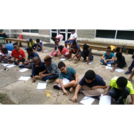
Teacher Overview Text
- Subject:
- Physical Science
- Material Type:
- Activity/Lab
- Author:
- OER LIBRARIAN
- Date Added:
- 02/17/2021

Teacher Overview Text

This lesson can work with any content standards. It is a lesson for students to learn a text marking procedure. Teachers and students can apply it to any non-fiction text on any non-fiction topic. Extensions include academic speaking and writing prompts.
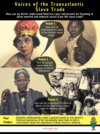
This unit begins by asking students to consider life in Africa before colonization and the forced enslavement of Africans. Students read Omar ibn Said’s autobiography to understand the Islamic scholar’s experiences before he was captured in West Africa and after he was enslaved in America. Excerpts from Olaudah Equiano’s autobiography provide a detailed glimpse of his childhood in Africa before he was kidnapped and sold into slavery. Students examine these two stories and others for evidence of resistance, liberation, connection to culture, and shared humanity as they develop a response to the question: How can we better understand America’s past and present by listening to often omitted and unheard voices from the slave trade? Working in teams, students create a podcast about an unheard story in order to start a conversation about the lasting effects of the Transatlantic slave trade and the importance of Black history in America.
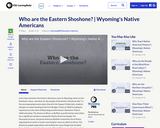
Learn how and when the Eastern Shoshone came to Wyoming, what are the Shoshone values, and what are the people of the Eastern Shoshone like? In the accompanying lessons plans (found in the Support Materials), students will gain an understanding of the Fort Bridger Treaty of 1868 including its importance to the state of Wyoming and the Eastern Shoshone Tribe in 1868 and today. The American Bison, or Buffalo as preferred by most tribes, has a significant existence among the Native American people. For thousands of years, the great American Buffalo roamed the Great Plains, migrating from north to south, searching for areas on which to thrive. The Shoshone people depended on the buffalo for many things that included food, clothing, and shelter. Every part of the buffalo was used and provided for the people.
LEARNING OBJECTIVES:
Students will study (Highlight, paraphrase and report) the Treaty of 1868 between the Eastern Shoshone Tribe and the United States Government.
Students will learn about the Eastern Shoshone people through the use of research and technology.
Students will understand that the history of the Shoshone people in the Wind River Mountains dates back thousands of years.
Students will understand that the circle of life continues in a perpetual cycle and is passed on through oral tradition. These stories often taught a lesson to young people.
Students will understand the indigenous perspective of interconnectedness. Students will understand how bison populations were devastated by western expansion.
Students will learn how to construct, read, compare and analyze different population graphs.
Students will understand how the diets of the Shoshone people varied depending on the areas in which they lived.
Students will acquire knowledge of the Wind River Reservation communities and be able to identify these locations on a map.
Students will be able to further describe how their culture has shaped them.
Students will be able to define the concept of culture.
Students will be able to explain some of the attributes of culture.
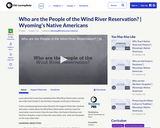
Learn about the treaty that estbalished the Wind River Reservation and the two tribes that inhabit it, the Northern Arapaho and Eastern Shoshone.
In the accompanying lesson plans (found in the Support Materials), students will watch a video about the Wind River Reservation and learn how the reservation came to exist, How the two tribes, the Eastern Shoshone and Northern Arapaho, come to share the reservation, and what are the people on the reservation like?
LEARNING OBJECTIVES:
Students will demonstrate an understanding about the 1868 Fort Bridger Treaty.
Students will create a map of the sacred sites fo the Shoshone and Araphaho Tribes.
Students will analyze the different pre and post reservation events for the Eastern Shoshone and Northern Arapaho tribes and evaluate why it is important for Wyoming state citizens to learn the history of the people of the Wind River Reservation
Students will gain an understanding of three spiritual sites in Wyoming.
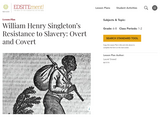
In this lesson, students will learn that enslaved people resisted their captivity constantly. Because they were living under the domination of their masters, slaves knew that direct, outright, overt resistance"”such as talking back, hitting their master or running away"“"“could result in being whipped, sold away from their families and friends, or even killed.
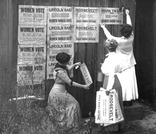
In this focused inquiry, students investigate the question: Are rights “granted” or “won?”. They will also consider: How did women rally support for the vote when they couldn’t vote themselves? What methods were used to gain the right to vote in Washington?
Students will engage in deep reading, develop summaries of information, conduct independent research, and engage in small and large group discussions and write an argument with a well-formed claim, clear evidence, and reasoning.
Photo of Washington Equal Suffrage Association posting signs to promote woman suffrage, Seattle by Curtis Asahel | Washington State Digital Archives. This image is made available for use in research, teaching, and private study.